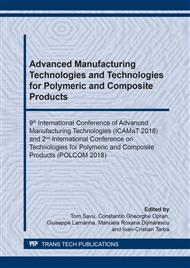[1]
Y. Xiao, T. Ishikawa, Bearing strength and failure behavior of bolted composite joints (part II: modeling and simulation), Compos. Sci. Technol. 65 (2005) 1032–1043.
DOI: 10.1016/j.compscitech.2004.12.049
Google Scholar
[2]
J.L. Chaboche, Continuum damage mechanics: part I – General concepts; part II – damage growth, crack initiation and crack growth, J. of App. Mech. 55 (1988) 59–72.
DOI: 10.1115/1.3173662
Google Scholar
[3]
F.K. Chang, K.Y. Chang, Post-failure analysis of bolted composite joints in tension or shear-out mode failure, J. Compos. Mat. 21 (1987) 809–33.
DOI: 10.1177/002199838702100903
Google Scholar
[4]
L.B. Lessard, M.M. Shokrieh, Two-dimensional modeling of composite pinned-joint failure, J. Compos. Mat. 29 (1995) 671–97.
DOI: 10.1177/002199839502900507
Google Scholar
[5]
C.L. Hung, F.K Chang, Bearing failure of bolted composite joints. Part II: model and verification, J. Compos. Mat. 30 (1996) 1359–400.
DOI: 10.1177/002199839603001204
Google Scholar
[6]
S.J. Kim, J.S. Hwang, J.H. Kim, Progressive failure analysis of pin-loaded laminated composites using penalty finite element method, J. AIAA, 36 (1998) 75–80.
DOI: 10.2514/2.354
Google Scholar
[7]
P.P. Camanho, F.L. Matthews, A progressive damage model for mechanically fastened joints in composite laminates, J. Compos. Mat. 33 (1999) 2248–80.
DOI: 10.1177/002199839903302402
Google Scholar
[8]
B. Okutan, The effects of geometric parameters on the failure strength for pin-loaded multi-directional fiber-glass reinforced epoxy laminate, Compos. Part B-Eng. 33 (2002) 567–8.
DOI: 10.1016/s1359-8368(02)00054-9
Google Scholar
[9]
K.I. Tserpes, G. Labeas, P. Papanikos, Th. Kermanidis, Strength prediction of bolted joints in graphite/epoxy composite laminates, Compos. Part B-Eng. 33 (2002) 521–9.
DOI: 10.1016/s1359-8368(02)00033-1
Google Scholar
[10]
Á. Olmedo, C. Santiuste, On the prediction of bolted single-lap composite joints, Compos. Struct. 94 (2012) 2110–7.
DOI: 10.1016/j.compstruct.2012.01.016
Google Scholar
[11]
Z. Kapidžić, L. Nilsson, H. Ansell, Finite element modeling of mechanically fastened composite-aluminum joints in aircraft structures, Compos. Struct. 109 (2014) 198–210.
DOI: 10.1016/j.compstruct.2013.10.056
Google Scholar
[12]
A.K. Zerbst, G. Kuhlmann, C. Steenbock, et al. Progressive damage analysis of composite bolted joints with liquid shim layers using constant and continuous degradation models, Compos. Struct. 92 (2010) 189–200.
DOI: 10.1016/j.compstruct.2009.05.011
Google Scholar
[13]
G. Kolks, KI. Tserpes. Efficient progressive damage modeling of hybrid composite/titanium bolted joints, Compos. Part A-Appl. S. 56 (2014) 51–63.
DOI: 10.1016/j.compositesa.2013.09.011
Google Scholar
[14]
B. Egan, M.A. McCarthy, R.M. Frizzell, P.J. Gray, C.T. McCarthy, Modelling bearing failure in countersunk composite joints under quasi-static loading using 3D explicit finite element analysis, Compos. Struct. 108 (2014) 963–977.
DOI: 10.1016/j.compstruct.2013.10.033
Google Scholar
[15]
Á. Olmedo, C. Santiuste, E. Barbero, An analytical model for the secondary bending prediction in single-lap composite bolted-joints, Compos. Struct. 111 (2014) 354–361.
DOI: 10.1016/j.compstruct.2014.01.015
Google Scholar
[16]
*** ASTM D 5961, Standard test method for bearing response of polymer matrix composite laminates, ASTM Int. (2007).
Google Scholar
[17]
*** MMPDS-05, Metallic Materials Properties development and Standardization, FAA, (2010).
Google Scholar
[18]
*** ASTM D 3039, Standard Test Method for Tensile Properties of Polymer Matrix Composite Materials, ASTM Int. (2007).
Google Scholar
[19]
*** ASTM D 5379, Standard Test Method for Shear Propeties of Composite Materials by the V-Notched Beam Method, ASTM Int, (2008).
Google Scholar
[20]
*** ASTM D 3410, Standard Test Method for Compressive Properties of Polymer Matrix Composite Materials, ASTM Int, (2007).
Google Scholar
[21]
M.A. McCarthy, C.T. McCarthy, V.P. Lawlor, W.F. Stanley, Three-dimensional finite element analysis of single-bolt, single-lap composite bolted joints: part I - model development and validation, Compos. Struct. 71 (2004) 140-158.
DOI: 10.1016/j.compstruct.2004.09.024
Google Scholar
[22]
H. Lamb, On Waves in an Elastic Adherent, Proc. of the Royal Society, Math. Phy. and Eng . Sci. 93 (1917) 114 – 128.
Google Scholar
[23]
V. Giurgiutiu, J. Bao, Embedded ultrasonic structural radar with piezoelectric wafer active sensors for the NDE of thin-wall structures, Proc. ASME Int. Mech. Eng. Congress, New Orleans, USA, (2002).
DOI: 10.1115/imece2002-33873
Google Scholar
[24]
H.T. Hahn, S.W. Tsai, Nonlinear elastic behavior of unidirectional composite laminates, J. of Compos. Mater. 7 (1973) 102–18.
Google Scholar
[25]
A. Du, Y. Liu, H. Xin, Y. Zuo. Progressive damage analysis of PFRP double-lap bolted joints using explicit finite element method, Compos. Struct. 152 (2016) 860–869.
DOI: 10.1016/j.compstruct.2016.06.028
Google Scholar
[26]
Z. Hashin, Failure criteria for unidirectional fiber composites, J. Appl. Mech. 80 (1973) 329–342.
Google Scholar


